


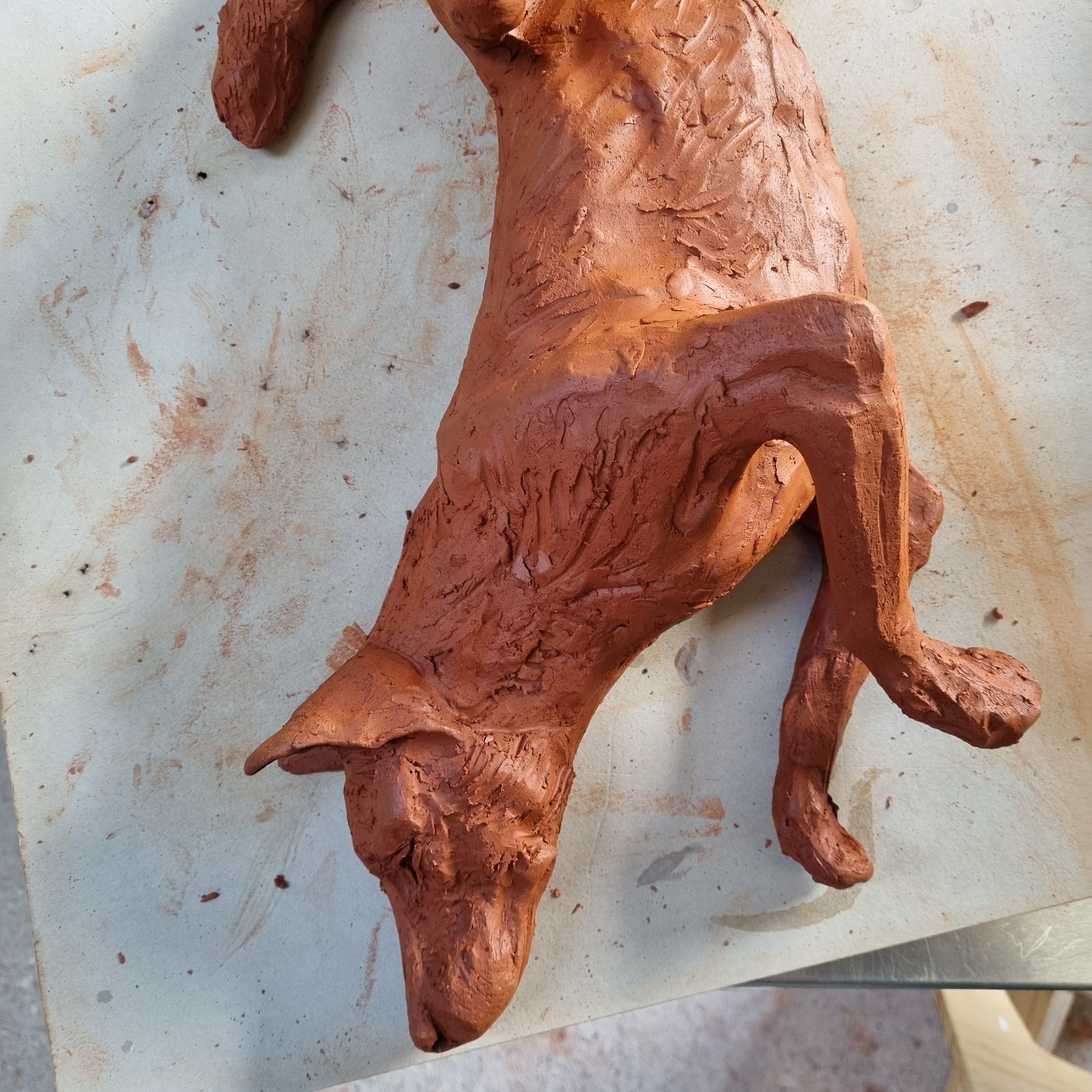
Relics of the Past, 2022 midfire clay, stains and glaze, lustre.
Finalist Heysen Landscape Prize, 2022
Hanging dingoes from trees is a form of communication amongst farmers, or between hunters. Used to deter other dogs and provide evidence a hunter can collect their bounty; their carcasses are left to swing from trees and fences across some regions of Australia. A motif for conflict and human impact, the dingo is listed as both a native animal and a restricted invasive animal, symbolising the uneasy relationship between human progress and native ecosystems.
Colonial settlers brought with them animals that altered the landscape and displaced the equilibrium. Today the persecution of dingoes has driven family packs into fragmented groups making them reliant on livestock and absent of an apex leader.
In this work the dingo hangs, accompanied by tools referencing early settler agricultural implements and traps. Rusted as relics, they are redundant. At risk, the dingo too shares a rusted patination, destined to be a relic of the past.


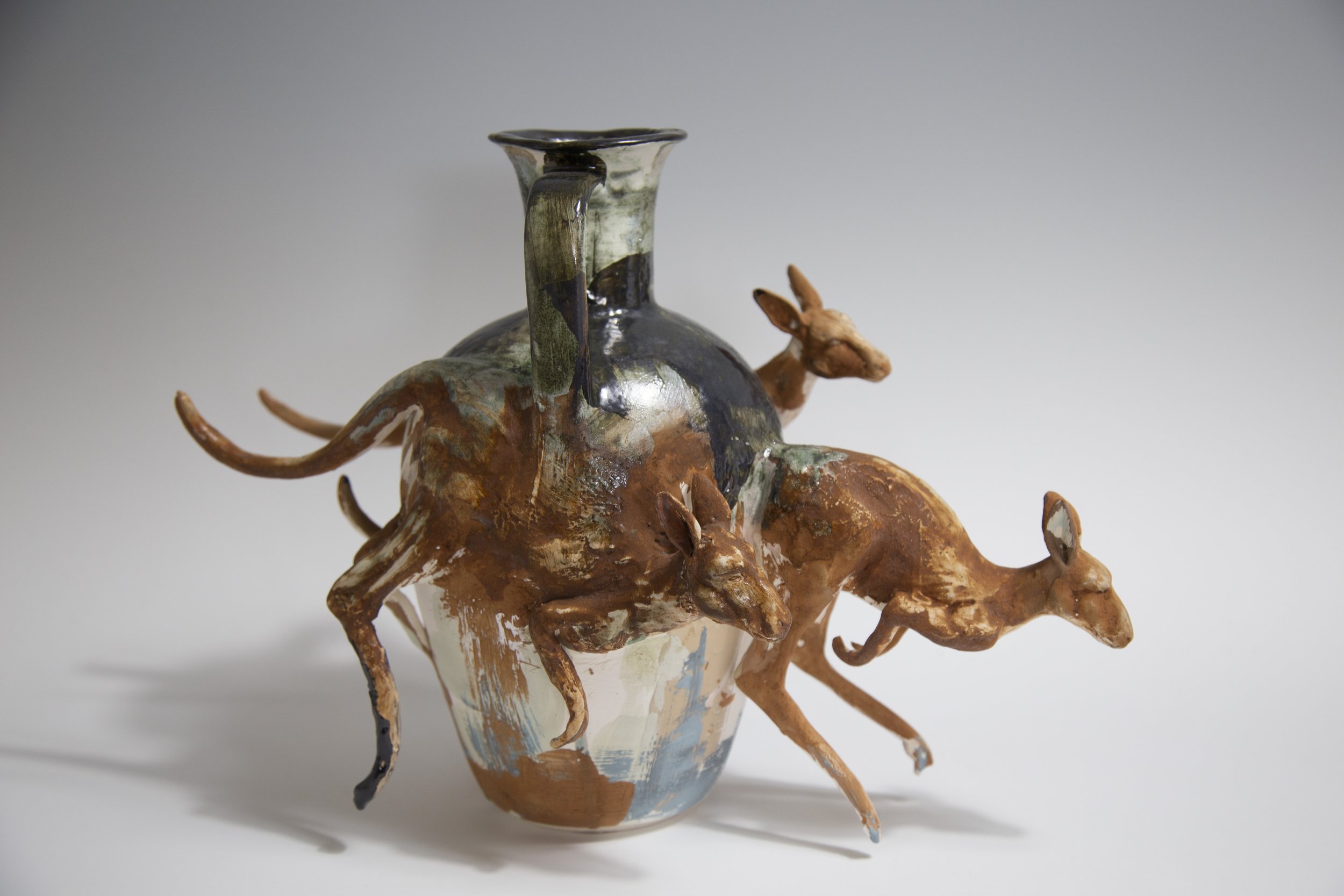

Terra Nullius, 2022 midfire clay, stains and glaze.
Finalist Heysen Landscape Prize, 2022
Terra Nullius is a juxtaposition of cultures, highlighting the conflict and change to the landscape caused by European infiltration. Invasion and settlement impacting and altering traditional ecological systems and leaving scars on the land. The vessel itself alludes to European rituals and artefacts, the kangaroos seen striving for escape and reflecting the end of the historic ways. Clustered together, the mob moves chaotically and strives for escape despite the restrictive powers that leave them contained. Agricultural boundaries, development and urban structures leaving old passages blocked and traditional grazing land inaccessible.
The patination reflects the Verdigris on old monuments after exposure to the elements, however despite the scarring, the colours of the land persist as a remnant of the country.
The vessel serves as a relic to the past and a monument to survival, reflecting on assimilation.


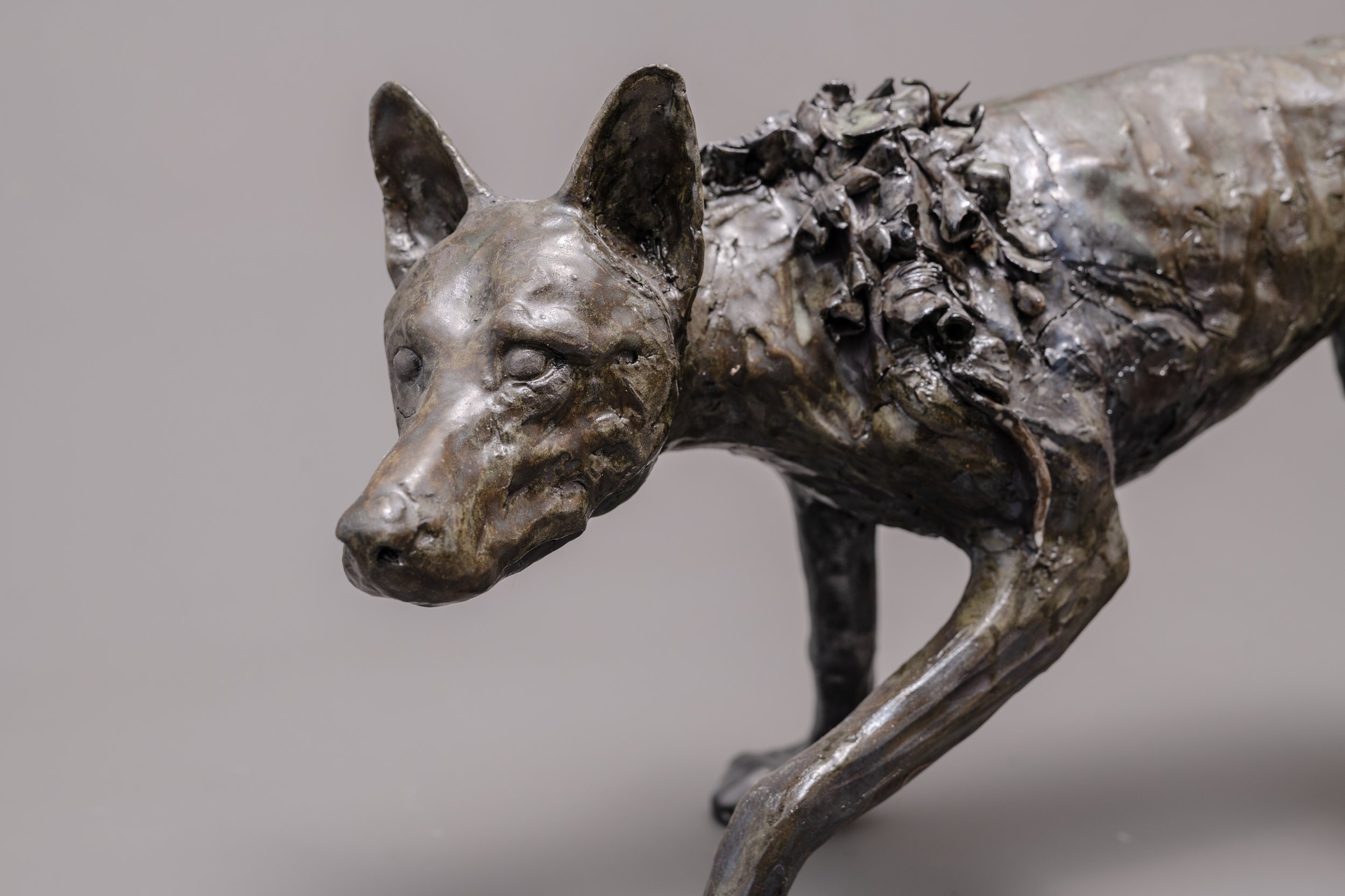
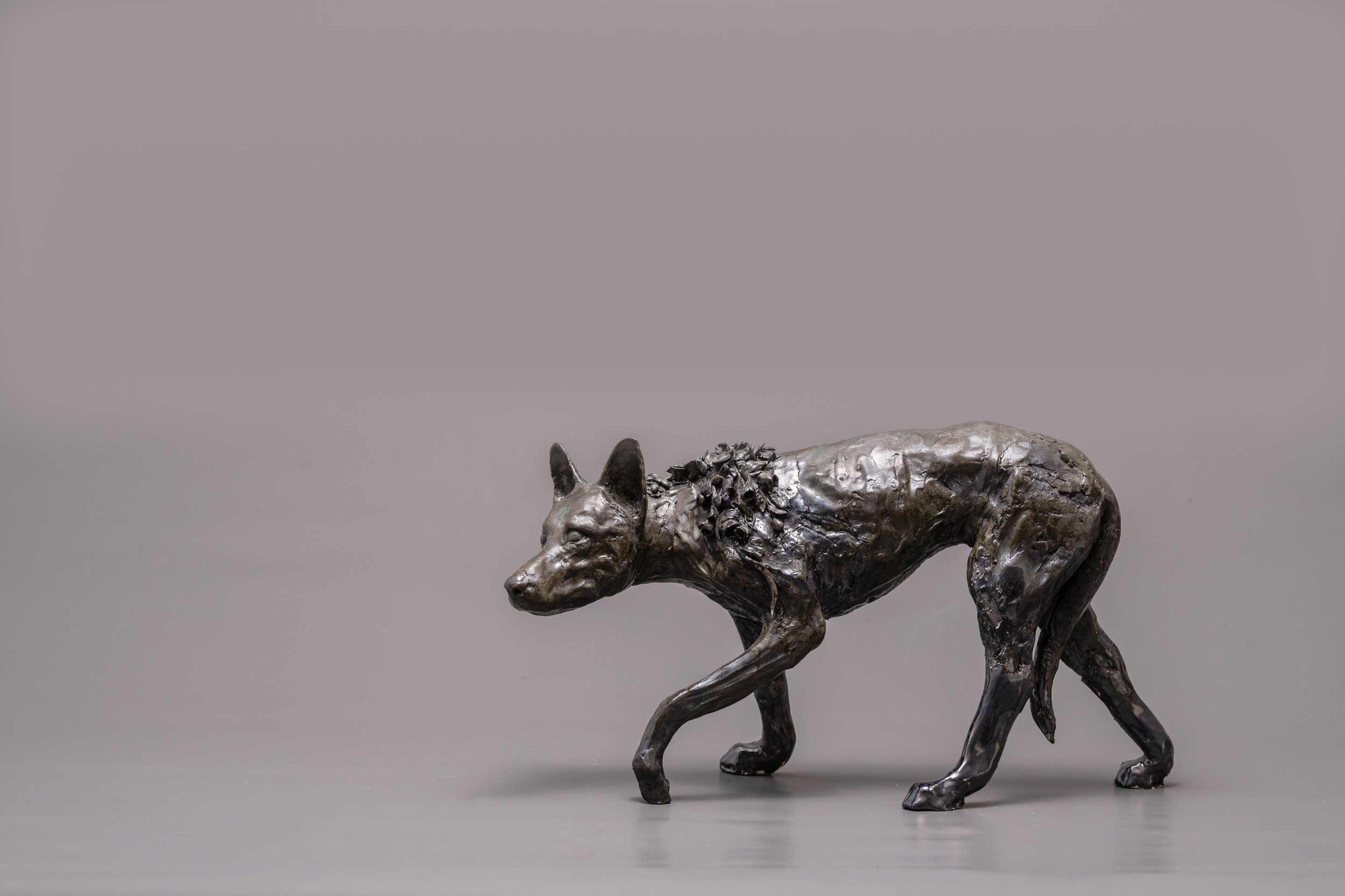
Herbaceous Border, 2022 midfire clay, stains and glaze.
Finalist NQ Ceramics Prize, 2022
This work reflects the challenges endured by native animals due to colonial impact. The animal reflective of Canis Dingo, prowls the landscape where boundaries have changed. Hunting and breeding grounds are impacted by progress and development and survival is a test. Around his neck, sits a floral chain reminiscent of the English Herbaceous Border. (A collection of plants arranged closely together to create a dramatic effect through colour and scale and used to define areas). In this instance the border suggests constraint and restriction as the eco system has altered and evolved in the face of European settlement. His surface patination has a green hue, reflective of the Verdigris on old monuments exposed to the elements.
Photo Evan Bailey
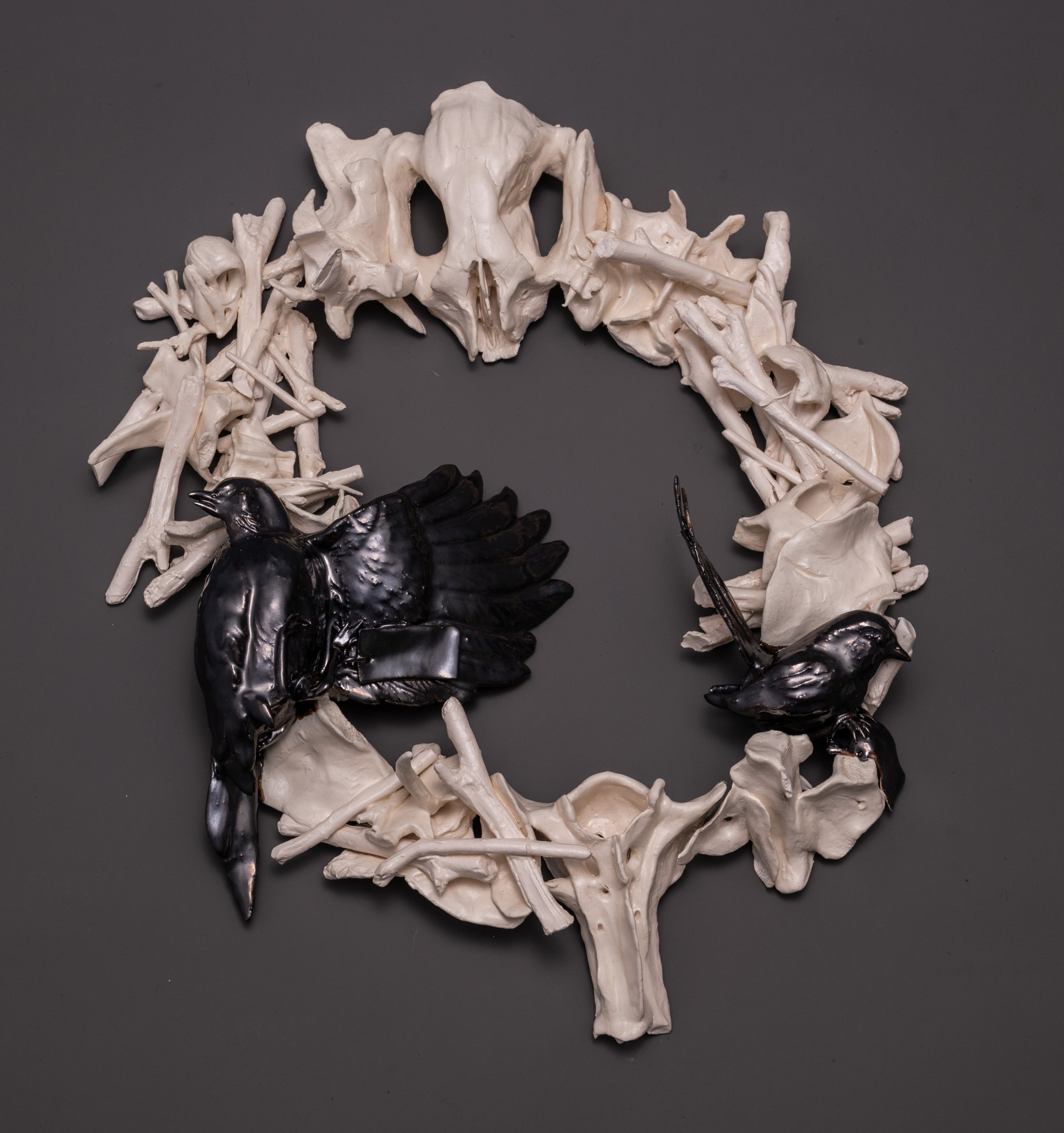




Strigiformes Census, 2022, hand-built ceramic earthenware, glaze.
Finalist Waterhouse Natural Science Art Prize, 2022
Owls, (order of Strigiformes) swallow their food whole, retaining the nutrients they need and discarding feathers and bones in expelled pellets. By identifying bones found in owl roosts conservationists have been able to determine animals that are in an area and most notably ascertain those that are absent. This hypothetical owl nest alludes to the remnants of fauna found in the owl’s roost and highlights those at risk, who are no longer present. Symbolised as patinated relics and tagged with museum specimen tags around their feet, endangered or extinct animals are no longer captured in the census.
Photo - Evan Bailey

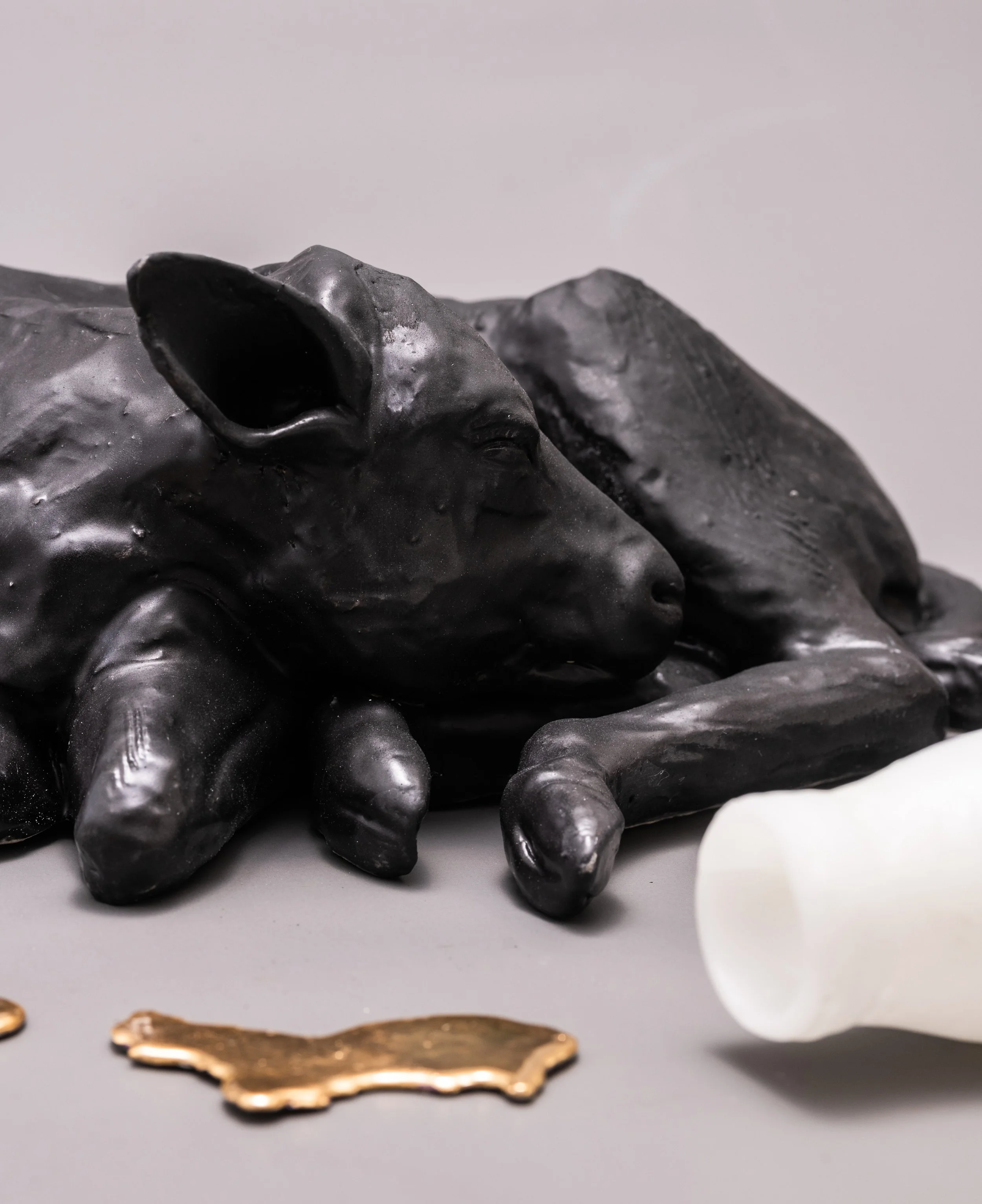


Wastage, 2021, ceramic earthenware, glaze and lustre
Dairy cows can be kept continually pregnant so that their milk can be consumed by humans. Wastage of the industry is the male calf, useless in this cycle. Like any mother, strong maternal bonds are formed and this practice causes suffering, distress and slaughter. In my own futile plight for motherhood I reflect on achieving childbirth and the prospect of having a child forcibly removed, considering those that have and continue to endure this trauma now and throughout our own history.
The black ‘bobby calf’ is motionless reminiscent of momento mori, inaccessible liquid (gold) milk is spilt around him.
Photo Evan Bailey
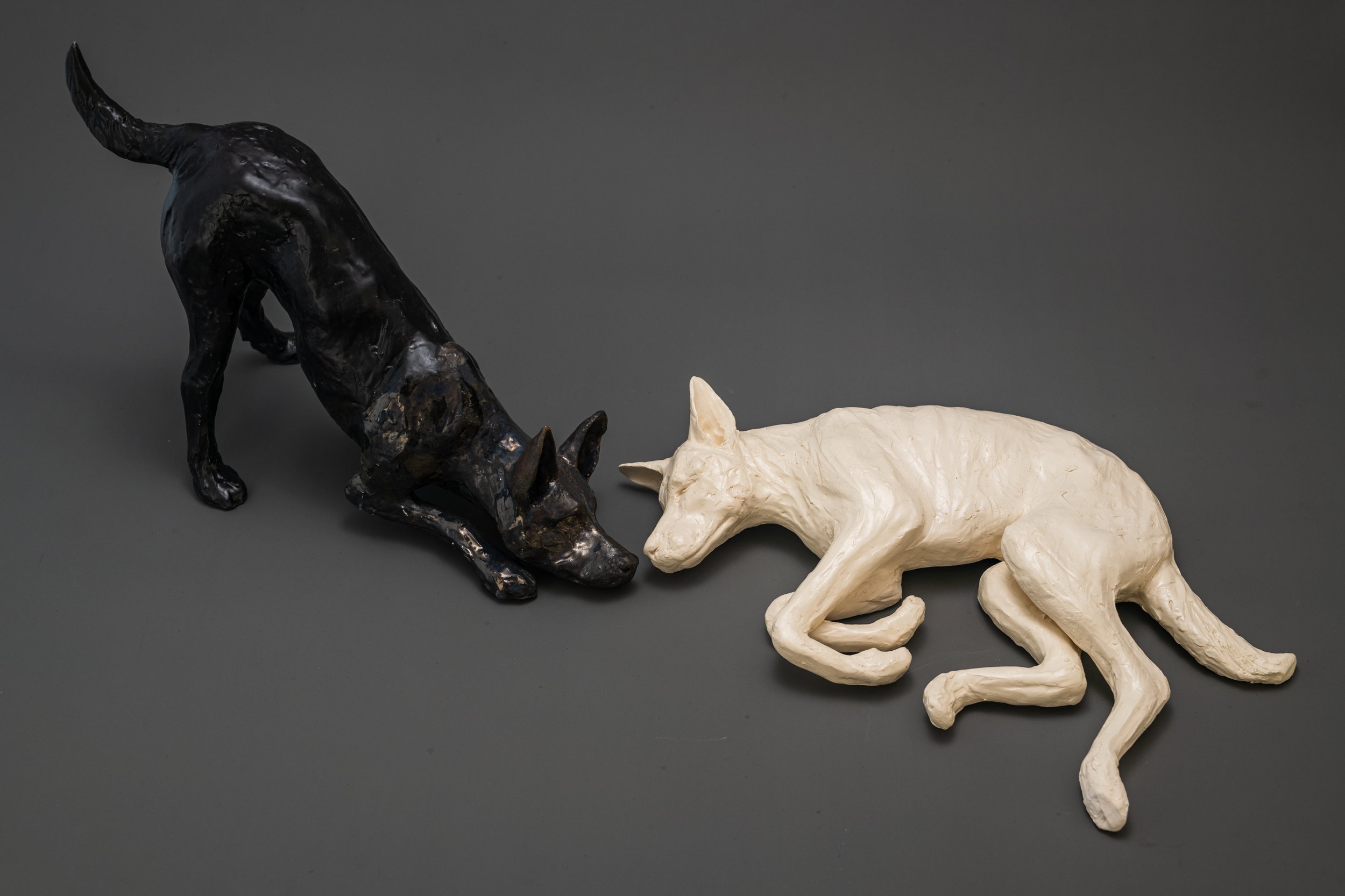
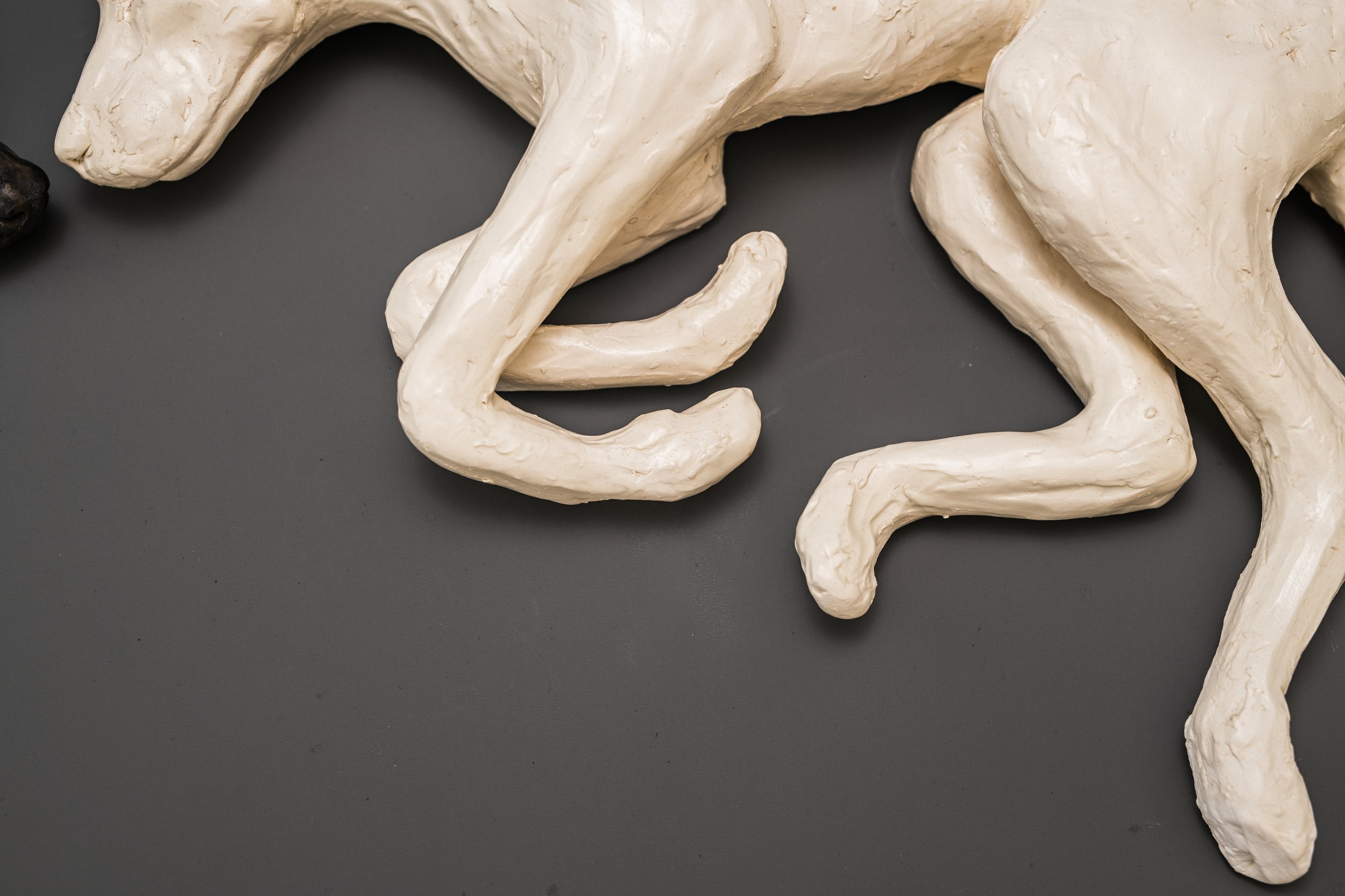


Hybrid Juxtaposition, 2022, earthenware clay and glaze.
This work explores the domestic attributes assigned to dogs, in contrast to the traits allocated to the Dingo. The two interacting dingoes appear in the act of play, but could be seen to be in conflict, dominance, or the act of submission as their future is unclear.
Traditionally highly valued pets and hunting dogs, dingoes are now considered at risk due to declining numbers and loss of habitat, their biggest threat comes from human impact and persecution. Despite being skilled at reading human gestures and at evolving to their surroundings, dingoes now appear destined on a trajectory of eradication. The contribution of poisoning through bait such as 1080, trapping to reduce livestock loss and the degradation of their genetics through breeding with domestic wild dogs has all taken a toll. Performing a vital role in ecological systems, a stable population of dingoes in the wild, could maintain an equilibrium amongst other native, prey species. Traditionally tan in colour, dingoes in fact come in a diverse range of colours, depicted here in black and white. Coat colour is not a true indicator of genetics or a measure of ancestry as research into culled black and white dogs in the Blue Mountains, assumed to be dingo-dog hybrids based on their coat colour may have in fact been pure dingoes.
Finalist North Sydney Art Prize, 2022
Photo Evan Bailey




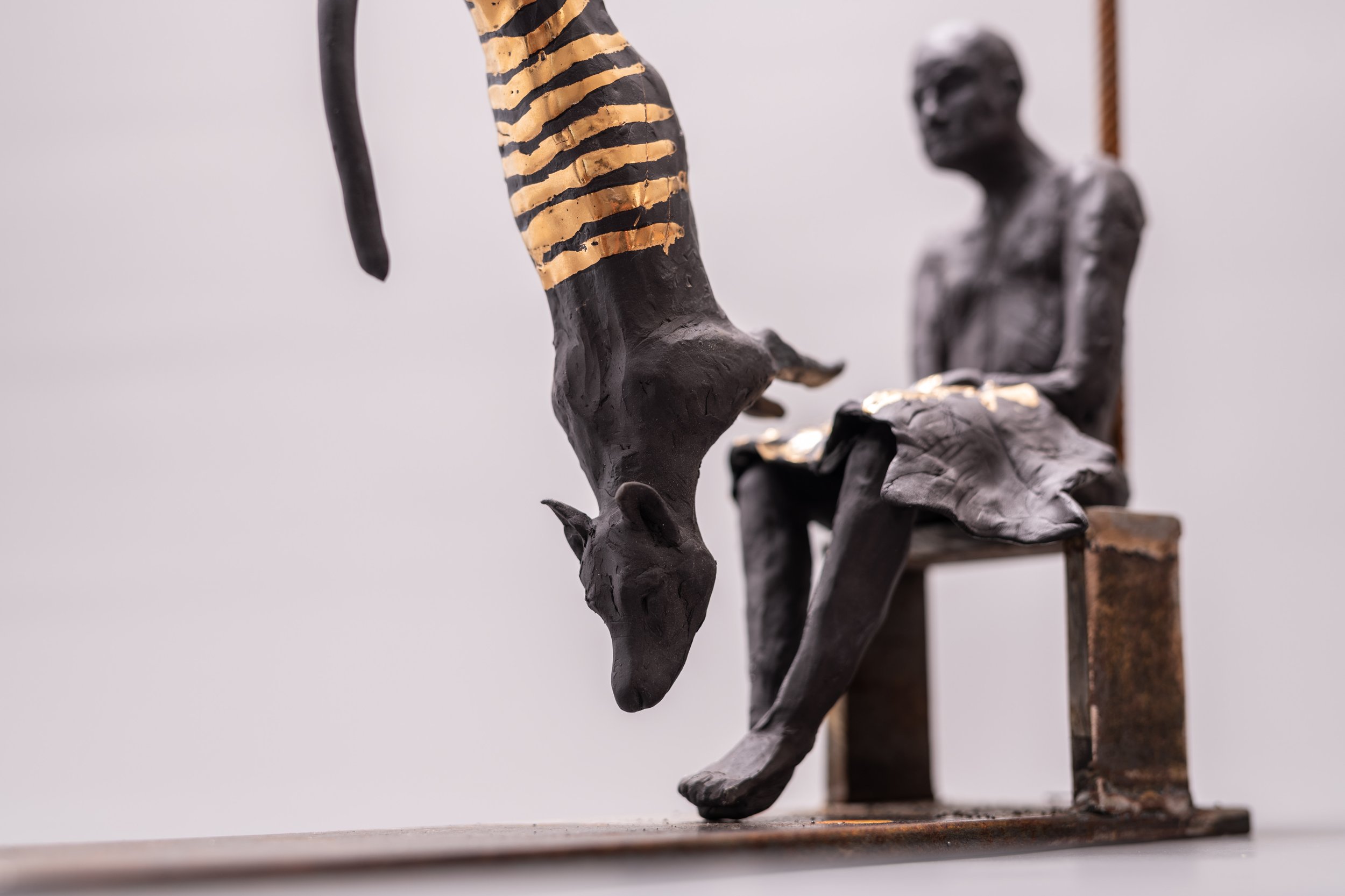
Sins of Man, 2021 hand-built mid fire black clay, lustre, steel
The footage of Benjamin, the last Thylacine, pacing a mesh enclosure is a haunting record of the last of his kind. An animal hunted persecuted and finally extinguished by Colonial settlers. The reference image for this work was of a hunter, posing with the corpse of his swaying prey. My work reflects that we have learned little from the past, as we continue to pillage, to destroy and to incapacitate – pushing many species of flora and fauna to the brink. Black clay was used as a medium to create a sense of monument and a relic of a moment in time, the stripes for which the Tiger was hunted shine like precious antiquities reflecting the burden that human impact can place on animal species, such as the Thylacine with his desirable pelt.
Photo Evan Bailey
Available to purchase contact for further information.




Progress, 2021, earthenware, cobalt carbonate, lustre
Finalist Adelaide Hills Prize for Landscape, 2021
This work explores the impact of human progress and development within the Adelaide Hills region. The kangaroo (referenced from an animal witnessed dazed in the road after a road collision) is used as a symbol of traditional ownership and flora and fauna in this area. Depicted on the animal is a blue scene representing early colonial settlements in the Strathalbyn region. Deliberately hazed in an effect reminiscent of 'blue flow,' a technique developed in traditional English ceramics. Juxtaposing this is a linear gold form, suggestive of a contemporary architectural blueprint, overriding the imagery of colonial tents and a pre-colonial landscape.
Whilst change and progress is inevitable, the impact on habitat and animal species causes great detriment to their future. As their land boundaries and passages are altered and they are no longer able to roam as they have done.
Photo: Evan Bailey
Birds, 2020, ceramic earthenware and cobalt carbonate.
A comment on human impact on the land since colonialism.
Available to purchase, please contact for further information.
Photo - Evan Bailey
Cat with birds, 2020, handbuilt ceramic earthenware, glazes and oxides.
This work references a sort of precolonial Australian dystopia. Blue imagery references English Delft and ceramicware, whilst endangered birds take flight, or lie deceased around the feral cat. A work that explores colonial conflict. Flora references botanical imagery recorded by Cook’s botanists at Desolation Island.
Dingo with Sevres Collar, 2020, handbuilt earthenware, oxides and glaze.
Early French explorers arrived in Botany Bay, NSW. Their Captain La Perouse, is now the namesake of this area.
The explorers established a garden soon after their arrival but only stayed for six weeks, quickly packing up and moving on. However their garden remained, left untended and free to roam.
A work that explores introduced species and the impact on native ecosystems.
Bounty, 2020, earthenware and underglazes.
The cat, imported to contain vermin, now it is the most destructive force in the Australian landscape. A prolific and successful hunter, the damage to native animals is irreipairable.
The cat ‘dips’ into the European ceramic ware, these motifs reminscent of the home land.
Dingo Vomit, 2019, earthenware, ceramic underglaze and dry enamel, .45 x 25 x 50 cm
Hand-built ceramic, glaze and dry enamel. A dog synonymous with Australia that explores cultural assimilation. The vomit of the dingo suggests indigestible ceramic flowers, reminiscent of British artifacts and Chelsea porcelain.











